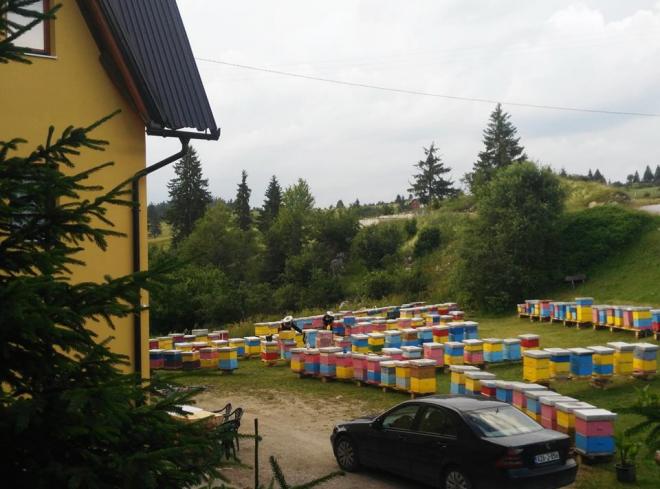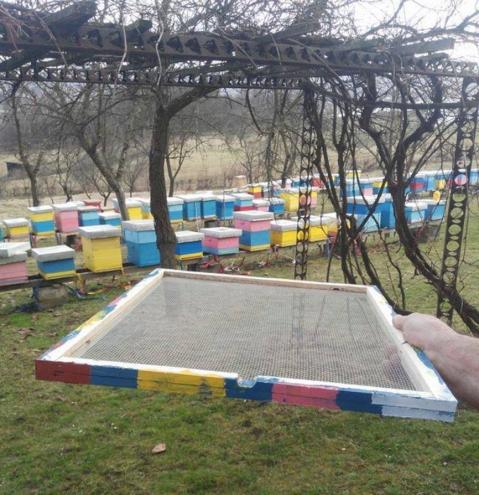Swarming is a natural instinct for reproduction of honey bee colonies to survive as a species.
Swarming is the process by which a new honey bee colony is formed when the queen bee leaves the colony with a large group of worker bees.
For example, honey bee Apis mellifera starts swarming when bee colony equalizes the number of open and closed brood. By then the bee colony already has male brood and drones (male bee). Beekeeper doesn't notice it until will there are eggs or larvae in queen cells, but it's too late to do anything.
Most of the beekeepers destroy queen cups trying to prevent swarming, but it is not very effective. It is important to emphasize that, as long as the bee colony has swarming urge its working enthusiasm is significantly reduced.Through the modernization of beekeeping, beekeepers are using technology to prevent natural bee swarming to achieve higher yields of honey and other bee products. Propagation of bee colonies in modern beekeeping is only done by artificial propagation in precisely planned and specified time.
Various more or less successful methods are used to prevent swarming. The common part of all these methods is to expand the workspace in order to create conditions for the active work of bees in all stages of their work engagement. Swarming urge, work engagement and expansion of workspace are in very close interdependence. In most cases, a large expansion cannot effectively affect the prevention of swarming urge, instead, it must be adjusted and done depending on every individual bee colony.

All these parameters are changing every day so a beekeeper must check each colony, at least every 5-7 days, to prevent swarming. Unfortunately, beekeepers with a lot of bee colonies are not able to check all colonies and take appropriate action which results in losses.
Poor records and loss of important information about your colonies is the problem with traditional methods of beehive management. Maybe it's a time to try the best beekeeping management application on the market? Try BeeRM for free and never forget again to check your colonies.
One very effective method of swarm prevention, which could be useful to beekeepers with a lot of colonies, is as follows.
In our climatic conditions, in Europe, bee colonies reach their optimum work phase just before acacia pasture. In that period brood supers and honey supers are separated by a queen excluder. Brood supers are on the floor, in the box where the queen excluder is located. Above a queen excluder, there is one, usually, even more, honey boxes. When bee colony gets swarming urge then honey supers are placed on the floor, where brood supers used to be. A framed wire mesh is put above the honey supers instead of a queen excluder. That wire mesh has frames in the same place where there were frames on a queen excluder. If a beekeeper doesn't have framed wire mesh then just put the regular mesh under framed queen excluder.

After two days everything goes back to its original position. In the meantime, worker bees left the brood chamber and entered a honey chamber. Brood chamber is left with only young bees and the queen. In these circumstances, bees got a large space, and also, have found themselves in need to prematurely continue to perform tasks of worker bees to provide themselves the necessary water or food. Because of these changed circumstances, bee colony gives up on swarming. After pheromone notification from the queen, bees demolish eventually started and even closed queen cups. That means that the swarming is interrupted and bees gave up on it, returning to their working mood.
So long story short, at the first sign of swarming, reverse the brood and supers. Supers on the bottom, brood and queen on top. Place some wired mesh between the Supers (now on the bottom) and brood boxes (now on top). A theory is that this causes a disruption in the bees by forcing them to do jobs they wouldn't otherwise be doing. After two days put everything back and remove the screen. By that time queen cells should be torn down and swarm urge should have passed.
Author: Ekrem Karahodžić
Source: Beekeeping farm Karahodžić (text and photos)